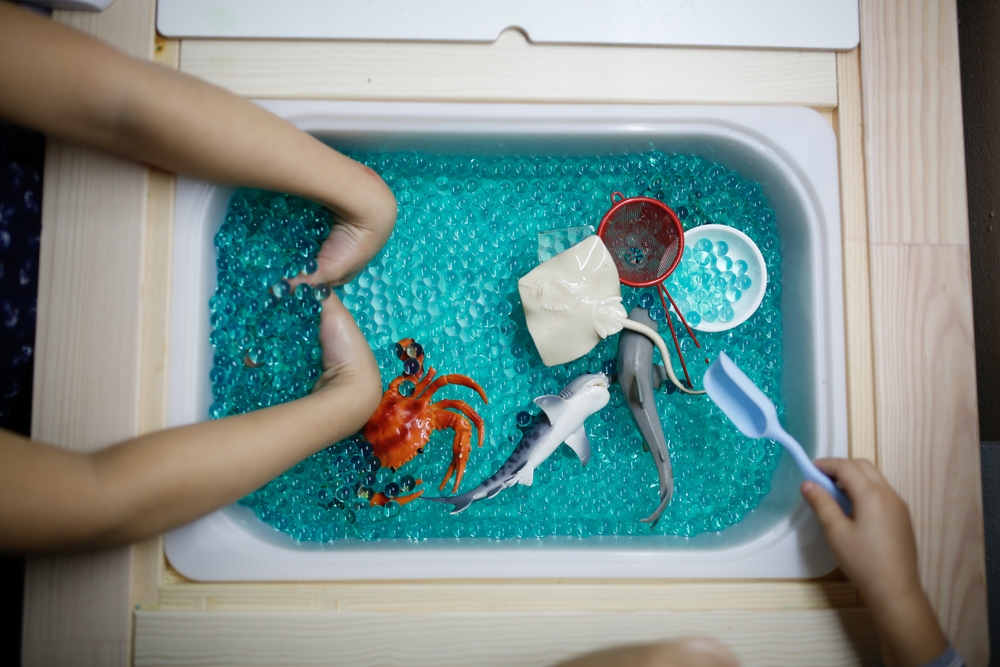Learning to self-soothe begins when most of us are babies.
Whether it’s sucking our thumb, cuddling a plush animal, blanket, or using a pacifier, being able to self-soothe is a natural part of our human development.
Often, many children continue these behaviors into their double digits.
Children with autism spectrum disorder (ASD) are no different in their need for self-soothing.
The difference is their behaviors often fall outside what is considered ‘socially acceptable’ behavior.
At Heartlinks, we’re often asked by concerned parents if their child’s autistic self-soothing strategies are typical. And should they be curtailed?
The answer always depends on several factors.
Is Self-Soothing the Same as Stimming?
Self-soothing is any behavior a person uses as emotional regulation. The behavior itself is usually repetitive and has a comforting or calming effect.
Stimming is an example of a self-soothing behavior.
It is not unique to children or adults on the spectrum, nor do all autistic people stim or exhibit self-stimulatory behavior.
Autistic children often use stimming to communicate in addition to self-soothing. It is considered one of the hallmarks of autism.
What are Some Examples of Stimming?

Autistic self-soothing techniques like stimming will look quite different from a neurotypical child’s.
Usually, stimming, when used as a calming strategy in autism, will include the following:
- Rocking
- Humming
- Singing
- Hand-flapping or waving
- Chewing non-food items (i.e. fingernails)
- Dancing
What is an Autistic Meltdown?
An intense response to emotional or physical overstimulation is called an autistic meltdown. Whether the child is expressing anxiety, excitement, frustration, or sadness due to being overstimulated, they can only get it out through an autistic meltdown.
To the untrained eye, the child might look like they’re having a temper tantrum. The difference is an autistic child’s meltdown is usually the result of sensory overload.
What are the Signs of an Impending Autism Meltdown?
It can be challenging to identify situations that may cause your autistic child to have a meltdown.
If you know that your child has a sensory processing disorder concerning noise, then you can plan to avoid noisy environments such as malls or public gatherings.
Yet the mystery of autism is that a large crowd at a sporting event might trigger your child, yet an equally sizeable group at a music concert may not cause an autism meltdown.
The following are just a few stimuli that could cause an autism tantrum.
- Bright or flickering lights
- Strong odors, such as heavily spiced food, fresh paint, the smell of bleach, and even pleasant scents, such as bread, right out of the oven.
- Changes to your child’s routine, like taking a different route to school or a substitute teacher
Before an autistic meltdown, your child may close their eyes, plug their nose, or cover their ears due to sensory overload.
The same overstimulation may cause them to retreat from a group of friends or leave a room altogether.
If you notice these subtle signs, the most effective thing you can do is start following the calming techniques before the situation gets out of control.
Examples of Calming Strategies for Kids with Autism
There are hundreds of different calming techniques available for autistic children depending on what stimuli overload them and what calms them the most efficiently.
Sensory Toys or Sensory Box
From squeezy toys and clay to fidget spinners and furry cubes, sensory toys are perhaps one of the most popular calming strategies for autism.
The reason is that they’re easy to transport in a purse or backpack, and they are affordable.
Not only can they help distract the child mid-meltdown, but they can also provide an excellent sensory distraction.
Keeping these sensory objects in a box or carrying individual ones around as needed can be life-saving in a meltdown situation.
Self-regulation techniques
Self-regulation isn’t something an autistic child will innately know how to do. Instead, it must be taught.
Applied Behavior Analysis (ABA) therapy is one of the easiest ways to teach emotional-regulation techniques to a child on the spectrum.
Whether breathing techniques, grounding exercises such as meditation, counting, or coloring, there are many ways to teach autism self-soothing techniques using ABA.
Provide an escape from the stressful situation
Simply walking away from a stressful situation can be a very effective autistic self-soothing technique.
By leaving the area, your child might be able to regain their control and reduce the stimulation.
Whether you move them to their bedroom, a comfy chair in another room, or the family bathroom, they can engage in self-regulation by physically removing themselves from the source of the overstimulation.
Provide distraction
Whether it’s talking about your child’s favorite stuffed animal or hobby, providing a distraction can be a sound calming strategy for autism.
Children and adults on the spectrum often have special interests and learn about them in extreme detail. Bringing up this interest before a meltdown may provide enough distraction to calm them down.
Other distraction options include, for example, if you’re attending a musical event with your child, pointing out the music to them might calm them. Have them listen intently to what’s being played and ask them to name the instruments when they’re played. By focusing on listening, your autistic child may disregard the other stimuli causing distress.
Get More Help at Heartlinks
At Heartlinks, we remind our parents that learning autism self-soothing techniques takes time and patience. There will be days when you’ll be able to avert a meltdown by providing the necessary calming music your child needs.
Conversely, there will be other times when, no matter how hard you’ve tried, the autistic meltdown occurs. You may feel defeated and saddened.
Remember, this is normal. Not being able to avoid meltdowns does not make you a bad parent. Instead, it makes you human.
For more information on how Heartlinks can help your family with autism self-soothing techniques, contact us here.
